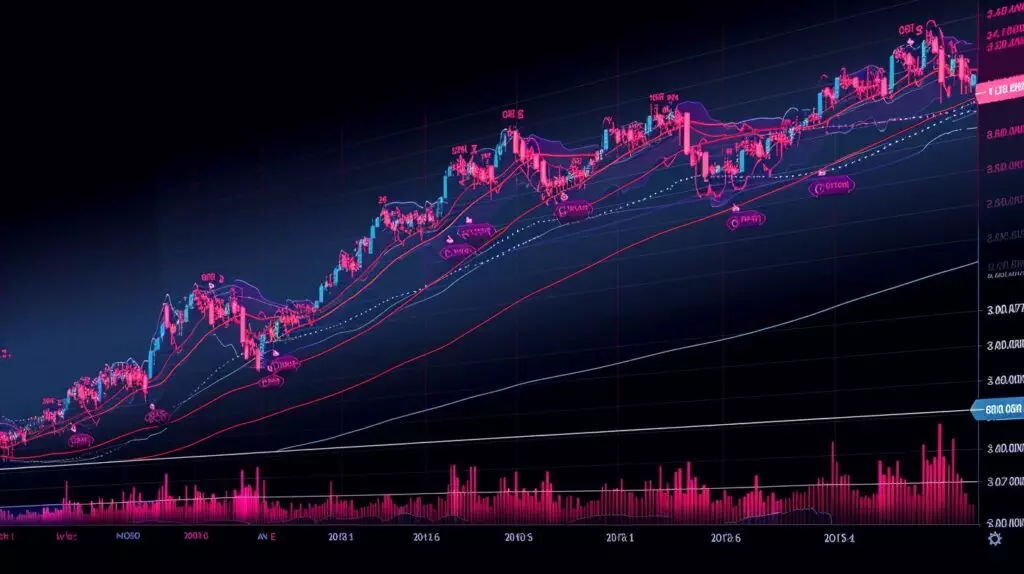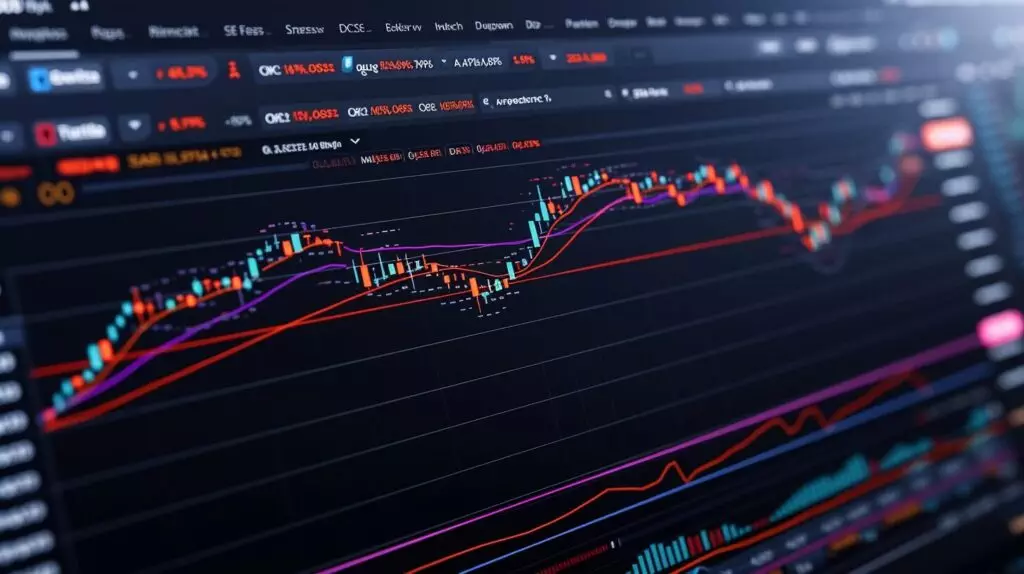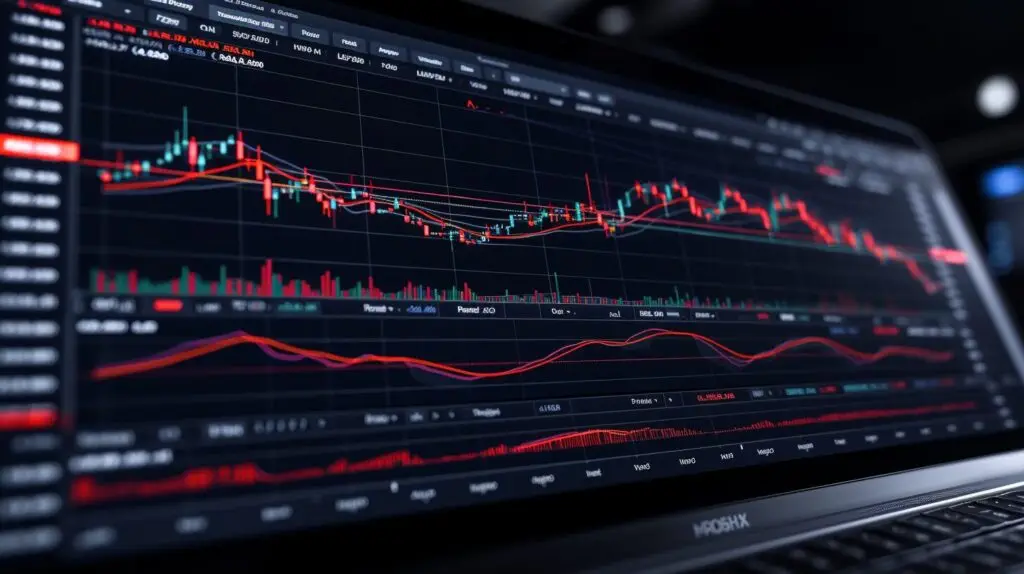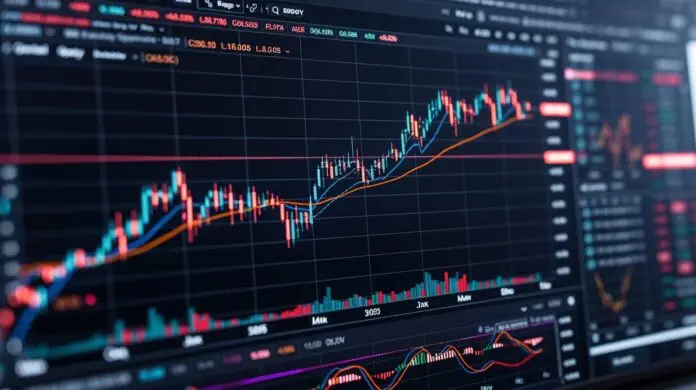Do you have knowledge about the QQQ 200-day moving average? This tool of technical analysis, when combined with technical indicators, proves to be greatly advantageous in forecasting market trends and pinpointing potential entry and exit points for the future trading day. But, what makes the 200-day moving average so important? What role does it play? And in what ways can you utilize this indicator to your advantage?
Key Takeaways
- The QQQs’ 200-day moving average is a reliable indicator of the long-term trend of the ETF.
- Trading above the moving average suggests an uptrend, while trading below it indicates a downtrend.
- The QQQ 200-day moving average can be used to determine potential entry and exit points for buying and selling, particularly in the near term.
- It is crucial to use the QQQ 200-day moving average, along with other fundamental analysis, for a comprehensive investment strategy.
Understanding the QQQ and Its Relevance in Technical Analysis

The QQQs, also known as the Invesco QQQ Trust, are exchange-traded funds (ETFs) that track the performance of the Nasdaq-100 Index. This index, known for its high growth ratios, consists of the 100 largest non-financial companies listed on the Nasdaq stock market, according to the day’s closing data.
The 200-day moving average is a widely used tool in technical analysis. It calculates the average closing price, eps, and volatility of a security over the past 200 trading days, providing a smoothed line that helps identify trends. The QQQs’ 200-day moving average is particularly relevant as it indicates the long-term trend of the ETF.
When the QQQs’ price is consistently trading above the 200-day moving average and shows favorable earnings per share, it suggests a bullish trend, indicating a buying opportunity. Conversely, if the price falls below the 200-day moving average, it may signal a bearish trend, prompting traders to consider selling their positions.
The Role of the 200 Day Moving Average in Technical Indicators

The 200-day moving average plays a critical role in providing insights into market trends and forecasting potential price movements. By plotting this average on a chart, traders can easily identify whether the price is trending upwards, downwards, or sideways.
The 200-day moving average helps identify potential trend reversals when the price crosses above or below it. It also acts as a significant support or resistance level. When the price is consistently trading above the 200-day moving average and maintains a strong dividend yield, it indicates a bullish trend. Conversely, when the price remains below the 200-day moving average, it suggests a bearish trend.
To better understand the role of the 200-day moving average in technical indicators, let’s take a look at the following table:
| Technical Indicator | Role of the 200-day Moving Average |
|---|---|
| Moving Average Crossover | Identifies potential trend reversals when the price crosses above or below the 200-day moving average. A bullish crossover occurs when the price moves above the 200-day moving average, indicating a potential uptrend. Conversely, a bearish crossover occurs when the price moves below the 200-day moving average, signaling a potential downtrend. |
| Support and Resistance | The 200-day moving average often acts as a significant support or resistance level. When the price approaches the 200-day moving average from below and bounces off it, it confirms the level as support. Conversely, when the price approaches the 200-day moving average from above and fails to break through, it confirms the level as resistance. |
| Trend Confirmation | The 200-day moving average helps confirm the overall trend of an asset. When the price is consistently trading above the 200-day moving average, it indicates a bullish trend. Conversely, when the price remains below the 200-day moving average, it suggests a bearish trend. |
Decoding the QQQ 200 Day Moving Average

The 200-day moving average is a popular tool used in technical analysis. It’s calculated by summing the closing prices of the QQQ over the past 200 trading days and then dividing that sum by 200. This calculation results in a smooth line that represents the average price of the QQQ over the past 200 days.
When the QQQ is trading above its 200-day moving average, it’s seen as a bullish signal, suggesting that the market is in an uptrend. Conversely, when the QQQ is trading below its 200-day moving average, displaying high volatility and a negative sentiment, it’s seen as a bearish signal, beckoning caution as the market might be in a downtrend. Considering the technical indicators, traders and investors use these signals to make informed decisions about buying or selling the QQQ.
Pivot Points and the QQQ 200 Day Moving Average

Pivot points are a popular tool used in technical analysis to identify key levels of support and resistance. By combining pivot points with the QQQ’s 200-day moving average, we can enhance our understanding of potential entry and exit points for this popular ETF, especially given the latest market conditions.
If the QQQ is trading above its 200-day moving average and a pivot point level coincides with this moving average, it suggests a potential buying opportunity. Conversely, if the QQQ is trading below its 200-day moving average and a pivot point level aligns with this moving average, it may indicate a potential selling opportunity.
Is the 200 Day Moving Average Suitable for Short-Term Trading on a 5 Min Chart?
Short-term trading on a 5-minute chart may not be ideal for the 200-day moving average. This long-term indicator is better suited for longer timeframes. For short-term trading, consider using shorter moving averages such as the 5 or 20-day to boost your trades with moving averages.
Using the QQQ 200 Day Moving Average to Guide Investment Decisions

Using the QQQ 200-day moving average as a guide, investors can make informed decisions regarding their investments. Here are four ways in which the QQQ 200-day moving average can guide investment decisions, given recent market trends and a faq about consolidations:
- Understanding the premium or discount on the QQQ 200-day moving average
- How the QQQ 200-day moving average can guide buy and sell strategies
- The risks and rewards of using the QQQ 200-day moving average in trading
- Incorporating the QQQ 200-day moving average, recent news, and a slight consolidation into a comprehensive investment strategy.
Conclusion
In conclusion, the get a technical analysis of the QQQ 200-day moving average is a valuable tool, offering insights into market behaviours and potential investment opportunities.
By understanding its role and decoding its signals, investors can use the QQQ 200 day moving average to guide their investment decisions.
Whether it’s identifying pivot points or gauging the market’s overall direction, this technical indicator can be a useful tool for traders and investors alike.
Frequently Asked Questions
What is QQQ 200 Day Moving Average Technical Analysis?
QQQ 200 Day Moving Average Technical Analysis is a comprehensive study utilizing various technical indicators such as MACD, RSI, and others to make informed investment decisions.
What are the key indicators to look for in QQQ 200 Day Moving Average Analysis?
Key indicators to consider in QQQ 200 Day Moving Average Analysis include the MACD and RSI signals, the stock’s position relative to its 50-day moving average, 50-day moving average crossover and the average true range (ATR).
Is the QQQ 200 Day Moving Average Analysis currently signaling a buy, strong buy, hold, or sell for the stock?
The current summary of technical analysis suggests a neutral stance, indicating a hold position for 2024 base. It’s important to monitor changes to the technical indicators for potential buying opportunities.
How can I interpret the MACD and RSI in the QQQ 200 Day Moving Average Analysis?
The latest MACD and RSI provide insights into the stock’s momentum and overbought or oversold conditions, which should be considered along with the 200-day moving average. Understanding their valuation values and the 2024 base helps gauge the stock’s potential directional movement and whether it may be overpriced.
Where can I get a complete technical analysis for QQQ 200 Day Moving Average?
You can find a detailed technical analysis for QQQ 200 Day Moving Average on websites like Barchart.com or by consulting with financial professionals who specialize in stock technical analysis.



